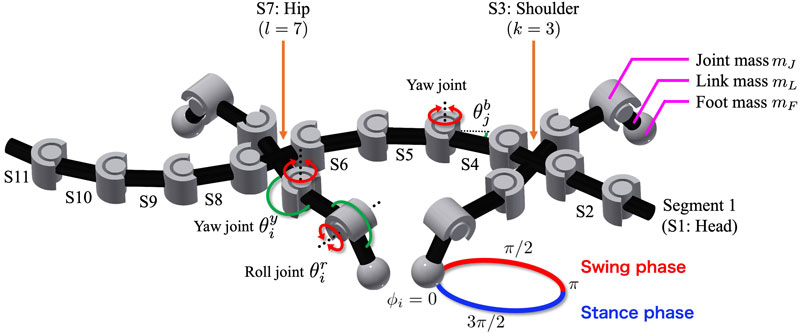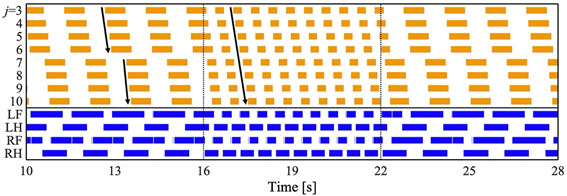Researchers at Tohoku University and the Swiss Federal Institute of Technology in Lausanne, with the support of the Human Frontier Science Program, have decoded the flexible motor control mechanisms underlying salamander walking.
Their findings were published in the journal Frontiers in Neurorobotics on July 30, 2021.
Animals with four feet can navigate complex, unpredictable, and unstructured environments. This impressive ability is thanks to their body-limb coordination.

Fig.1: Schematic of salamander walking with lateral body bending.
The salamander is an excellent specimen for studying body–limb coordination mechanisms. It is an amphibian that uses four legs and walks by swaying itself left and right in a motion known as undulation.
Their nervous system is simpler than those of mammals, and they change their walking pattern according to the speed at which they are moving.

Fig. 2: Control mechanisms comprise three types of feedback rules. The interactions between the sensory feedback establishes flexible body–limb coordination.
To decode the salamander’s movement, researchers led by Professor Akio Ishiguro of the Research Institute of Electrical Communication at Tohoku University modeled the salamander’s nervous system mathematically and physically simulated the model.
In making the model, the researchers hypothesized that the legs and the body are controlled to support other motions by sharing sensory information. They then reproduced the speed-dependent gait transitions of salamanders through computer simulations.
“We hope this finding provides insights into the essential mechanism behind the adaptive and versatile locomotion of animals,” said Ishiguro.
The researchers are confident their discovery will aid the development of robots that can move with high agility and adaptability by flexibly changing body–limb coordination patterns.

Fig. 3: Simulated salamander model. The trunk has 10 rotary joints and each leg has two rotary joints.

Fig. 4: Body–limb coordination pattern in response to the speeds: the orange-colored region denotes the period when the j-th trunk joint from the head bends to the right. The blue-colored region denotes the period when the foot is in contact with the ground (LF: left fore, LH: left hind, RF: right fore, RH: right hind). During the period 16-22 [s], the simulated salamander shows fast walking. Other than that, it shows slow walking. At fast walking, the traveling waves of lateral undulation propagate posteriorly, and a diagonal pair of the feet touch down synchronously. At slow walking, the standing waves of lateral undulation emerge and the footfall order is right hind, right fore, left hind, and left fore. These speed-dependent behaviors are consistent with the salamander’s behaviors.


































